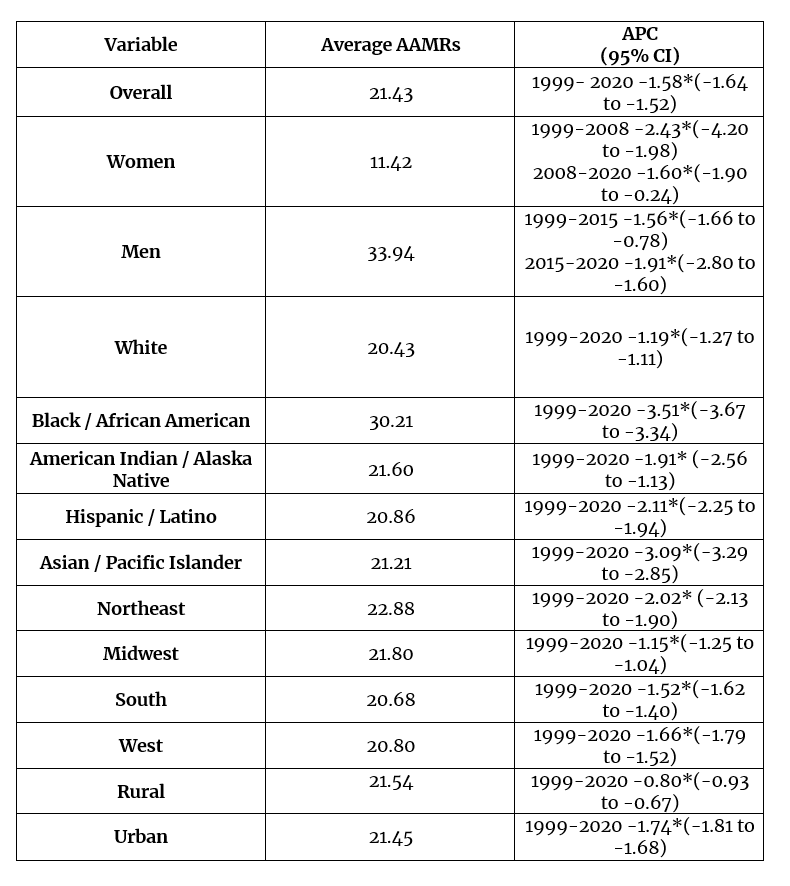Tuesday Poster Session
Category: Stomach and Spleen
P6331 - Analyzing Trends in Upper Gastrointestinal Tract Cancer Mortality Rates in the United States From 1999-2020
Tuesday, October 28, 2025
10:30 AM - 4:00 PM PDT
Location: Exhibit Hall

Amine Rakab, MD (he/him/his)
Division of Medical Education, Weill Cornell Medicine
Doha, Ad Dawhah, Qatar
Presenting Author(s)
Huda Ahmed, MD1, Umar Khan, MD2, Bisher Sawaf, MD3, Ahmad Shahid, MD4, Amine Rakab, MD5, Muhammad Hamza Shuja, MD6, Amin Abu Hejleh, MD7, Syed Hasan Shuja, MD6
1Dow University of Health Sciences, Karachi, Azad Kashmir, Pakistan; 2Dow University of Health Sciences, Kashmir, Azad Kashmir, Pakistan; 3The University of Toledo, Toledo, OH; 4Dow Medical College, Kashmir, Azad Kashmir, Pakistan; 5Division of Medical Education, Weill Cornell Medicine, Doha, Ad Dawhah, Qatar; 6Dow Medical College, Toledo, Azad Kashmir, Pakistan; 7Mohammed Bin Rashid University of Medicine and Health Sciences, Dubai, Dubai, United Arab Emirates
Introduction: Gastrointestinal (GI) cancers account for approximately a quarter of global cancer cases, with one-third occurring in the upper tract (esophagus, stomach, duodenum). Their shared etiology warrants a collective mortality trend analysis to identify vulnerable populations. This study analyzes mortality trends in upper GI cancer mortality in the U.S. from 1999-2020.
Methods: We utilized death certificate data from the CDC WONDER database spanning 1999–2020, focusing on upper GI tract cancers using ICD-10 codes: C15.0–C15.5, C15.8–C15.9, C16.0–C16.6, C16.8–C16.9, and C17.0. Age-adjusted mortality rates (AAMRs) per 100,000 population were calculated and stratified by sex, race/ethnicity, age group, geographic region, and urbanization. Joinpoint regression analysis identified statistically significant changes in temporal trends, expressed as Average Annual Percent Change (AAPC).
Results: A total of 559,403 deaths from upper GI cancers were recorded in the U.S. from 1999 to 2020, with an overall decline in mortality (AAPC: -1.58%). Men exhibited a substantially higher mortality rate than women (mean AAMR: 33.93 vs. 11.42) and a slower decline in rates (AAPC: -1.62% vs. -1.96%). Non-Hispanic (NH) Black individuals had the highest AAMRs (21.6) but also experienced the steepest decline (AAPC: -3.51%). Other racial/ethnic groups had the following AAMRs: NH American Indian/Alaska Native (79.5), NH Asian/Pacific Islander (22.21), Hispanic (20.86), and NH White (20.43). Regionally, the Northeast had the highest burden (AAMR: 22.8) but also the greatest decline (AAPC: -2.02%), while the Midwest saw the slowest decrease (AAPC: -1.15%). Urban areas had higher AAMRs in 1999 (25.92) compared to rural areas (23.34), but experienced a sharper decline (AAPC: -1.74% vs. -0.80%), resulting in lower mortality in urban areas by 2020 (20.1 vs. 21.45). State-level analysis showed the District of Columbia (AAMR: 28.62), Alaska (25.51), Rhode Island (24.29), Maine (24.16), Massachusetts (23.93), and Louisiana (23.81) ranked in the top 90th percentile for mortality burden.
Discussion: This study found a sustained decline in upper GI cancer mortality, reflecting advancements in preventative medicine, screening modalities, and targeted treatment. However, persistent disparities remain among males, African Americans, and rural populations. This highlights the need for tailored public health approaches and healthcare reforms to better reach high-risk groups and enhance outcomes.

Figure: Table: Deaths, Average Age-adjusted mortality rates (AAMR), and Annual Percent Change (APC) of Upper Gastrointestinal Tract Cancer Mortality in the U.S., 1999 - 2020
Disclosures:
Huda Ahmed indicated no relevant financial relationships.
Umar Khan indicated no relevant financial relationships.
Bisher Sawaf indicated no relevant financial relationships.
Ahmad Shahid indicated no relevant financial relationships.
Amine Rakab indicated no relevant financial relationships.
Muhammad Hamza Shuja indicated no relevant financial relationships.
Amin Abu Hejleh indicated no relevant financial relationships.
Syed Hasan Shuja indicated no relevant financial relationships.
Huda Ahmed, MD1, Umar Khan, MD2, Bisher Sawaf, MD3, Ahmad Shahid, MD4, Amine Rakab, MD5, Muhammad Hamza Shuja, MD6, Amin Abu Hejleh, MD7, Syed Hasan Shuja, MD6. P6331 - Analyzing Trends in Upper Gastrointestinal Tract Cancer Mortality Rates in the United States From 1999-2020, ACG 2025 Annual Scientific Meeting Abstracts. Phoenix, AZ: American College of Gastroenterology.
1Dow University of Health Sciences, Karachi, Azad Kashmir, Pakistan; 2Dow University of Health Sciences, Kashmir, Azad Kashmir, Pakistan; 3The University of Toledo, Toledo, OH; 4Dow Medical College, Kashmir, Azad Kashmir, Pakistan; 5Division of Medical Education, Weill Cornell Medicine, Doha, Ad Dawhah, Qatar; 6Dow Medical College, Toledo, Azad Kashmir, Pakistan; 7Mohammed Bin Rashid University of Medicine and Health Sciences, Dubai, Dubai, United Arab Emirates
Introduction: Gastrointestinal (GI) cancers account for approximately a quarter of global cancer cases, with one-third occurring in the upper tract (esophagus, stomach, duodenum). Their shared etiology warrants a collective mortality trend analysis to identify vulnerable populations. This study analyzes mortality trends in upper GI cancer mortality in the U.S. from 1999-2020.
Methods: We utilized death certificate data from the CDC WONDER database spanning 1999–2020, focusing on upper GI tract cancers using ICD-10 codes: C15.0–C15.5, C15.8–C15.9, C16.0–C16.6, C16.8–C16.9, and C17.0. Age-adjusted mortality rates (AAMRs) per 100,000 population were calculated and stratified by sex, race/ethnicity, age group, geographic region, and urbanization. Joinpoint regression analysis identified statistically significant changes in temporal trends, expressed as Average Annual Percent Change (AAPC).
Results: A total of 559,403 deaths from upper GI cancers were recorded in the U.S. from 1999 to 2020, with an overall decline in mortality (AAPC: -1.58%). Men exhibited a substantially higher mortality rate than women (mean AAMR: 33.93 vs. 11.42) and a slower decline in rates (AAPC: -1.62% vs. -1.96%). Non-Hispanic (NH) Black individuals had the highest AAMRs (21.6) but also experienced the steepest decline (AAPC: -3.51%). Other racial/ethnic groups had the following AAMRs: NH American Indian/Alaska Native (79.5), NH Asian/Pacific Islander (22.21), Hispanic (20.86), and NH White (20.43). Regionally, the Northeast had the highest burden (AAMR: 22.8) but also the greatest decline (AAPC: -2.02%), while the Midwest saw the slowest decrease (AAPC: -1.15%). Urban areas had higher AAMRs in 1999 (25.92) compared to rural areas (23.34), but experienced a sharper decline (AAPC: -1.74% vs. -0.80%), resulting in lower mortality in urban areas by 2020 (20.1 vs. 21.45). State-level analysis showed the District of Columbia (AAMR: 28.62), Alaska (25.51), Rhode Island (24.29), Maine (24.16), Massachusetts (23.93), and Louisiana (23.81) ranked in the top 90th percentile for mortality burden.
Discussion: This study found a sustained decline in upper GI cancer mortality, reflecting advancements in preventative medicine, screening modalities, and targeted treatment. However, persistent disparities remain among males, African Americans, and rural populations. This highlights the need for tailored public health approaches and healthcare reforms to better reach high-risk groups and enhance outcomes.

Figure: Table: Deaths, Average Age-adjusted mortality rates (AAMR), and Annual Percent Change (APC) of Upper Gastrointestinal Tract Cancer Mortality in the U.S., 1999 - 2020
Disclosures:
Huda Ahmed indicated no relevant financial relationships.
Umar Khan indicated no relevant financial relationships.
Bisher Sawaf indicated no relevant financial relationships.
Ahmad Shahid indicated no relevant financial relationships.
Amine Rakab indicated no relevant financial relationships.
Muhammad Hamza Shuja indicated no relevant financial relationships.
Amin Abu Hejleh indicated no relevant financial relationships.
Syed Hasan Shuja indicated no relevant financial relationships.
Huda Ahmed, MD1, Umar Khan, MD2, Bisher Sawaf, MD3, Ahmad Shahid, MD4, Amine Rakab, MD5, Muhammad Hamza Shuja, MD6, Amin Abu Hejleh, MD7, Syed Hasan Shuja, MD6. P6331 - Analyzing Trends in Upper Gastrointestinal Tract Cancer Mortality Rates in the United States From 1999-2020, ACG 2025 Annual Scientific Meeting Abstracts. Phoenix, AZ: American College of Gastroenterology.
